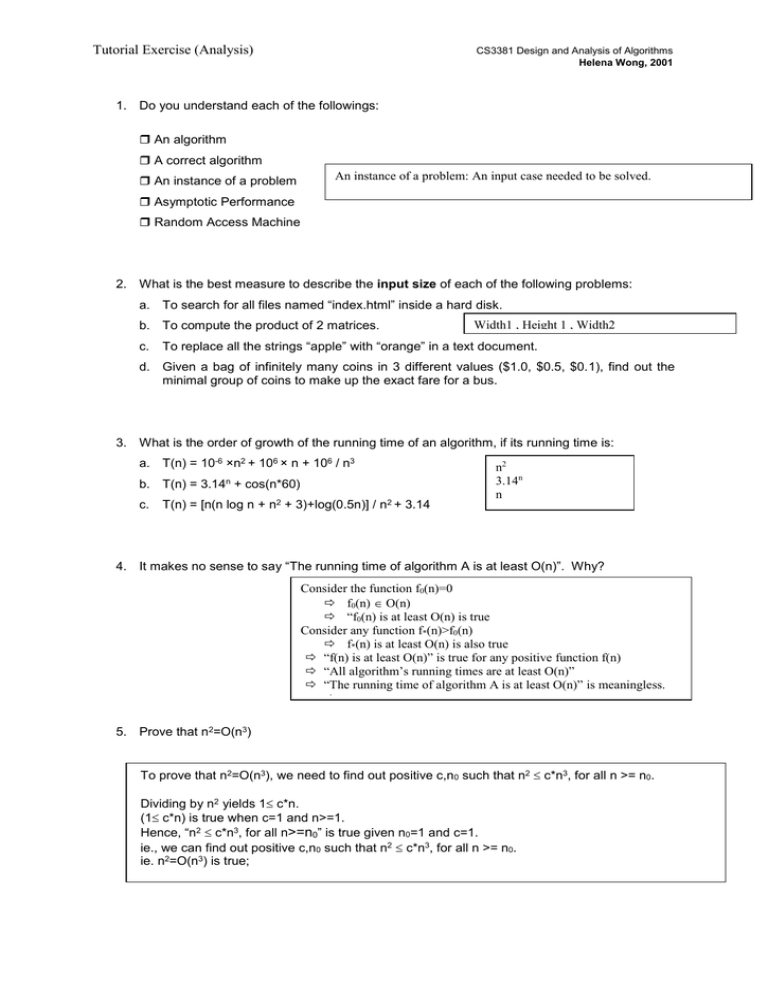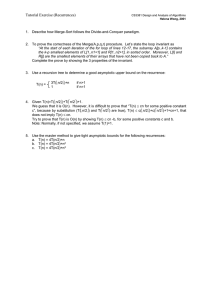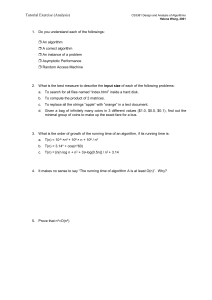Tutorial Exercise (Analysis)
advertisement

Tutorial Exercise (Analysis) CS3381 Design and Analysis of Algorithms Helena Wong, 2001 1. Do you understand each of the followings: An algorithm A correct algorithm An instance of a problem An instance of a problem: An input case needed to be solved. Asymptotic Performance Random Access Machine 2. What is the best measure to describe the input size of each of the following problems: a. To search for all files named “index.html” inside a hard disk. b. To compute the product of 2 matrices. c. Width1 , Height 1 , Width2 To replace all the strings “apple” with “orange” in a text document. d. Given a bag of infinitely many coins in 3 different values ($1.0, $0.5, $0.1), find out the minimal group of coins to make up the exact fare for a bus. 3. What is the order of growth of the running time of an algorithm, if its running time is: a. T(n) = 10-6 ×n2 + 106 × n + 106 / n3 b. T(n) = 3.14n + cos(n*60) c. T(n) = [n(n log n + n2 + 3)+log(0.5n)] / n2 + 3.14 n2 3.14n n 4. It makes no sense to say “The running time of algorithm A is at least O(n)”. Why? Consider the function f0(n)=0 f0(n) O(n) “f0(n) is at least O(n) is true Consider any function f*(n)>f0(n) f*(n) is at least O(n) is also true “f(n) is at least O(n)” is true for any positive function f(n) “All algorithm’s running times are at least O(n)” “The running time of algorithm A is at least O(n)” is meaningless. 5. Prove that n2=O(n3) To prove that n2=O(n3), we need to find out positive c,n0 such that n2 c*n3, for all n >= n0. Dividing by n2 yields 1 c*n. (1 c*n) is true when c=1 and n>=1. Hence, “n2 c*n3, for all n>=n0” is true given n0=1 and c=1. ie., we can find out positive c,n0 such that n2 c*n3, for all n >= n0. ie. n2=O(n3) is true; Tutorial Exercise (Analysis) CS3381 Design and Analysis of Algorithms Helena Wong, 2001 6. Prove that 2n2-5n=(n2) To prove 2n2-5n=(n2), we need to find out positive c1,c2,n0 such that c1*n2 2n2-5n c2*n2, for all n >= n0. Dividing by n2 yields: c1 2-5/n c2 Take c1 = 0.1, c2=100, n0=30 For 2-5/n c2 For c1 2-5/n Consider that 5/n is positive whenever n>=1. => 2-5/n 2 for all n1 => 2-5/n c2 for all nn0 => 2n2-5n c2*n2 for all nn0 Consider that (2-5/n) is an increasing function, and (2-5/n0)=1.833 => 2-5/n1.833 for all nn0 => 2-5/nc1 for all nn0 => 2n2-5nc1*n2 for all nn0 => c1*n2 2n2-5n for all nn0 Conclusion, “c1*n2 2n2-5n c2*n2, for all n n0” is true given c1=0.1, c2=100, n0=30. (Indeed, it is also true for any c1, c2 and n0 such that they are 1/3, 2, and 3 respectively. See the proof in the course web page). ie., we can find out positive c1,c2,n0 such that c1*n2 2n2-5n c2*n2, for all n n0. Therefore, 2n2-5n=(n2). 7. Write an algorithm (in pseudocode) to compute the product of all the odd integers in an nonempty array. Using a loop invariant, prove that your algorithm is correct. function ProductOdd(A,n) 1 result=1; 2 for i=1 to n 3 4 5 if A[i] is odd result = result * A[i] return result; Loop Invariant: At the start of each iteration of the for loop, if i=1, then result contains 1, otherwise, result contains the product of all the odd integers in A[1..i-1]. Initialization: Before the first iteration, i=1 and result contains 1 => Loop invariant holds Maintenance: The for loop checks that if A[i] is odd, then result is multiplied with A[i], otherwise result is not changed. Hence, if the loop invariant is true before an iteration, it remains true before next iteration. Termination: The for loop ends with i=n+1, and i<>1 since A is not empty. Substituting n+1for i in the loop invariant, we get result contains the product of all odd integers in A[1..n]. Tutorial Exercise (Analysis) CS3381 Design and Analysis of Algorithms Helena Wong, 2001 8. The following algorithm counts the number of male students enrolled in both of 2 courses (A and B). Assume that the class sizes of both courses are n, n>50. function AlgorithmA(A,B) 1 result = 0; 2 for i=1 to n 3 4 5 if A[i] is male for j=1 to n if A[i]=B[j] 6 result = result + 1; 7 break; //stop iterating the inner for-loop. 8 return result; What are the best, average, and worst cases of this algorithm [Assume that the courses are equally welcomed by male and female students, and all students enrolled in A will enroll or not enroll in B with equal possibility]? Best case: all course A students are female Average case: half of course A students are male and half of these male students are found in course B’s list, evenly distributed. Worst case: all course A students are male and none of them study course B. By direct observation, state the order of growth of the running time of each of the 3 cases. Best case: n Worst case: n2 Average case: n2 Formulate the running times with abstract coefficients to prove your observation. Let t3a = number of male students in course A. Let t4 = number of times line 4 is executed. Let t5 = number of times line 5 is executed. Let t6 = number of times line 6 is executed. T(n)=C1+C2(n+1)+C3(n)+C4(t4)+C5(t5)+C6(t6)+C7(t6)+C8 Best case: t3a=0, t4=t5=t6=0 => T(n)= C1+C2(n+1)+C3(n)+C8=An+B Worst case: t3a=n, t4=n(n+1),t5=n2, t6=0=> T(n)= C1+C2(n+1)+C3(n)+C4(n*(n+1))+C5(n2)+C6(0)+C7(0)+C8=An2+Bn+C Average case: t3a=n/2, t6=n/4,t5=n/4*(n)+n/4*n/2=(3/8)n2 , t4= n/4*(n+1)+n/4*n/2=(3/8)n2+n/4, T(n)=C1+C2(n+1)+C3(n)+C4((3/8)n2+n/4)+C5* ((3/8)n2) +C6(n/4)+C7(n/4)+C8=An2+Bn+C Describe the running times in terms of a. Asymptotic Upper Bound, b. Asymptotic Lower Bound, and/or c. Asymptotic Tight Bound Best case: (c) (n) Worst case: (c) (n2) Average case: (c) (n2) AlgorithmA: (a) O(n2), (b) (n)





